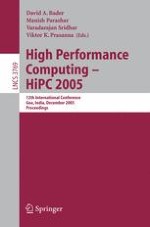2005 | Book
High Performance Computing – HiPC 2005
12th International Conference, Goa, India, December 18-21, 2005. Proceedings
Editors: David A. Bader, Manish Parashar, Varadarajan Sridhar, Viktor K. Prasanna
Publisher: Springer Berlin Heidelberg
Book Series : Lecture Notes in Computer Science
